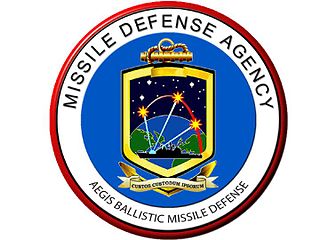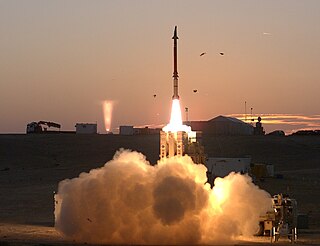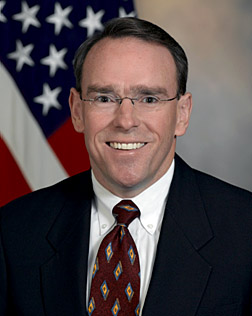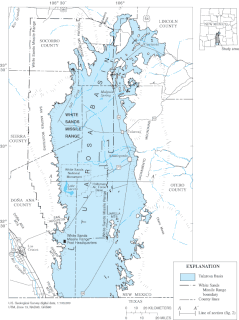
An anti-ballistic missile (ABM) is a surface-to-air missile designed to counter ballistic missiles. Ballistic missiles are used to deliver nuclear, chemical, biological, or conventional warheads in a ballistic flight trajectory. The term "anti-ballistic missile" is a generic term conveying a system designed to intercept and destroy any type of ballistic threat, however it is commonly used for systems specifically designed to counter intercontinental ballistic missiles (ICBMs).

The Strategic Defense Initiative (SDI) was a proposed missile defense system intended to protect the United States from attack by ballistic strategic nuclear weapons. The concept was first announced publicly by President Ronald Reagan on 23 March 1983. Reagan was a vocal critic of the doctrine of mutual assured destruction (MAD), which he described as a "suicide pact", and he called upon the scientists and engineers of the United States to develop a system that would render nuclear weapons obsolete.

The MIM-104 Patriot is a surface-to-air missile (SAM) system, the primary of its kind used by the United States Army and several allied nations. It is manufactured by the U.S. defense contractor Raytheon and derives its name from the radar component of the weapon system. The AN/MPQ-53 at the heart of the system is known as the "Phased Array Tracking Radar to Intercept on Target" which is a backronym for PATRIOT. The Patriot System replaced the Nike Hercules system as the U.S. Army's primary High to Medium Air Defense (HIMAD) system, and replaced the MIM-23 Hawk system as the U.S. Army's medium tactical air defense system. In addition to these roles, Patriot has been given the function of the U.S. Army's anti-ballistic missile (ABM) system, which is now Patriot's primary mission. The system is expected to stay fielded until at least 2040.

The Arrow or Hetz is a family of anti-ballistic missiles designed to fulfill an Israeli requirement for a missile defense system that would be more effective against ballistic missiles than the MIM-104 Patriot surface-to-air missile. Jointly funded and produced by Israel and the United States, development of the system began in 1986 and has continued since, drawing some contested criticism. Undertaken by Israel Aerospace Industries (IAI) and Boeing, it is overseen by the Israeli Ministry of Defense's "Homa" administration and the U.S. Missile Defense Agency.

The Aegis Ballistic Missile Defense System is a United States Department of Defense Missile Defense Agency program developed to provide missile defense against short to intermediate-range ballistic missiles. It is part of the United States national missile defense strategy. Aegis BMD is designed to intercept ballistic missiles post-boost phase and prior to reentry.

National missile defense (NMD) is a generic term for a type of missile defense intended to shield an entire country against incoming missiles, such as intercontinental ballistic missile (ICBMs) or other ballistic missiles.

Terminal High Altitude Area Defense (THAAD), formerly Theater High Altitude Area Defense, is an American anti-ballistic missile defense system designed to shoot down short-, medium-, and intermediate-range ballistic missiles in their terminal phase by intercepting with a hit-to-kill approach. THAAD was developed after the experience of Iraq's Scud missile attacks during the Gulf War in 1991. The THAAD interceptor carries no warhead, but relies on its kinetic energy of impact to destroy the incoming missile. A kinetic energy hit minimizes the risk of exploding conventional-warhead ballistic missiles, and the warhead of nuclear-tipped ballistic missiles will not detonate upon a kinetic-energy hit.

The Missile Defense Agency (MDA) has its origins in the Strategic Defense Initiative (SDI) which was established in 1983 by Ronald Reagan which was headed by Lt. General James Alan Abrahamson. Under the Strategic Defense Initiative's Innovative Sciences and Technology Office headed by physicist and engineer Dr. James Ionson, the investment was predominantly made in basic research at national laboratories, universities, and in industry. These programs have continued to be key sources of funding for top research scientists in the fields of high-energy physics, supercomputing/computation, advanced materials, and many other critical science and engineering disciplines—funding which indirectly supports other research work by top scientists, and which was most politically viable to fund within the Military budget of the United States environment. It was renamed the Ballistic Missile Defense Organization in 1993, and then renamed the Missile Defense Agency in 2002. The current commander is U.S. Air Force Lt. Gen. Samuel A. Greaves.

Missile defense is a system, weapon, or technology involved in the detection, tracking, interception, and destruction of attacking missiles. Originally conceived as a defence against nuclear-armed intercontinental ballistic missiles (ICBMs), its application has broadened to include shorter-ranged non-nuclear tactical and theater missiles.
Simon "Si" Ramo was an American engineer, businessman, and author. He led development of microwave and missile technology and is sometimes known as the father of the intercontinental ballistic missile (ICBM). He also developed General Electric's electron microscope. He played prominent roles in the formation of two Fortune 500 companies, Ramo-Wooldridge and Bunker-Ramo.

The Indian Ballistic Missile Defence Programme is an initiative to develop and deploy a multi-layered ballistic missile defence system to protect from ballistic missile attacks.

The RIM-161 Standard Missile 3 (SM-3) is a ship-based missile system used by the United States Navy to intercept short- and intermediate-range ballistic missiles as a part of Aegis Ballistic Missile Defense System. Although primarily designed as an anti-ballistic missile, the SM-3 has also been employed in an anti-satellite capacity against a satellite at the lower end of low Earth orbit. The SM-3 is primarily used and tested by the United States Navy and also operated by the Japan Maritime Self-Defense Force.

David's Sling, also formerly known as Magic Wand, is an Israel Defense Forces military system being jointly developed by the Israeli defense contractor Rafael Advanced Defense Systems and the American defense contractor Raytheon, designed to intercept enemy planes, drones, tactical ballistic missiles, medium- to long-range rockets and cruise missiles, fired at ranges from 40 km to 300 km. David's Sling is meant to replace the MIM-23 Hawk and MIM-104 Patriot in the Israeli arsenal.

The EL/M-2080 Green Pine is an Israeli ground-based missile-defense radar produced by Elta, a subsidiary of Israel Aerospace Industries, to operate mainly with the Arrow theater missile defense system of Israel, which is jointly funded and produced with the United States. Green Pine was exported to India, and its advanced version, the Green Pine Block-B, was delivered to South Korea at a cost of $83 million apiece, and to Azerbaijan. The Israeli Air Defense Command within the Israeli Air Force (IAF) of the Israel Defense Forces (IDF) operates both Green Pine radars and Green Pine Block-B radars as an integral part of the Arrow system.

John Jacob Young Jr. was United States Assistant Secretary of the Navy from 2001 to 2005 and Under Secretary of Defense for Acquisition, Technology and Logistics from 2007 to 2009. He is the founder and principal of JY Strategies, LLC.
Missile defense systems are a type of missile defense intended to shield a country against incoming missiles, such as intercontinental ballistic missile (ICBMs) or other ballistic missiles. The United States, Russia, India, France, Israel and China have all developed missile defense systems.

The Arrow 3 or Hetz 3 is an exoatmospheric hypersonic anti-ballistic missile, jointly funded, developed and produced by Israel and the United States. Undertaken by Israel Aerospace Industries (IAI) and Boeing, it is overseen by the Israeli Ministry of Defense's "Homa" administration and the U.S. Missile Defense Agency. It provides exo-atmospheric interception of ballistic missiles, including intercontinental ballistic missiles (ICBMs) carrying nuclear, chemical, biological or conventional warheads. With divert motor capability, its kill vehicle can switch directions dramatically, allowing it to pivot to see approaching satellites. The missile may have a reported flight range of up to 2,400 km (1,500 mi).
Dr. William Ames "Bill" Davis Jr. was an engineer and distinguished leader in Ballistic Missile Defense (BMD) for the United States Army at Redstone Arsenal in Huntsville, AL. Davis is an inaugural member of the United States Senior Executive Service (SES) and recipient of numerous accolades and awards from the Army including the Meritorious Civilian Service Award (1980) and the Department of the Army Decoration for Exceptional Civilian Service (1982).
Leon Jablecki is an American rocket scientist.





























